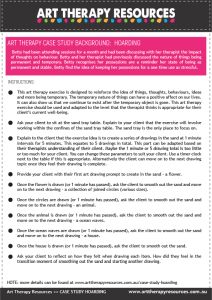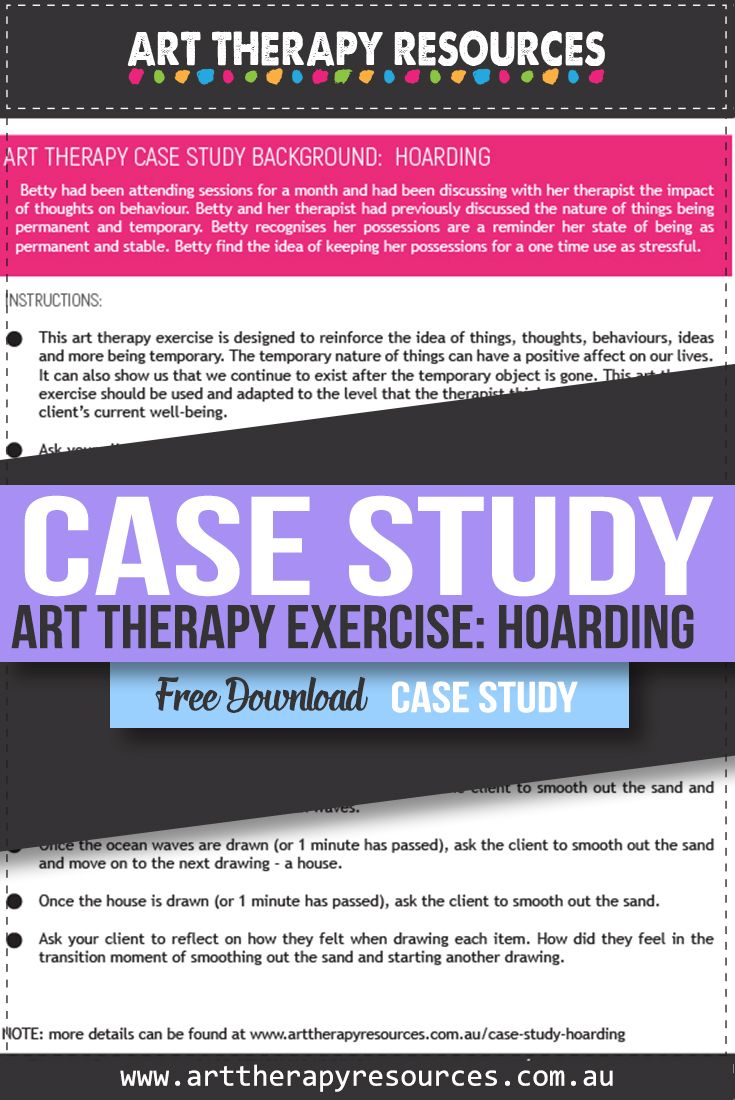THIS POST INCLUDES:
- Art Therapy and Hoarding
- About the Client
- Current Client Issues
- Art Therapy Exercise
- Client Insight and Outcomes
- Disclaimer
- FREE DOWNLOAD Art Therapy Exercise
ART THERAPY AND HOARDING
Hoarding refers to the stockpiling of items by people. This includes both an accumulation phase as well as difficulty discarding items. These items can include inanimate objects or animals where the individual can exert control over their stockpiling behaviours.
The American Psychiatric Association defines hoarding as relating to people “.. with hoarding disorder excessively save items that others may view as worthless. They have persistent difficulty getting rid of or parting with possessions, leading to clutter that disrupts their ability to use their living or work spaces.”
In many cases of hoarding, people persistently collect so many items that their living space becomes unhygienic, unsafe, and unlivable. Even at this stage of hoarding, an individual will still refuse to rectify their living environment.
This is an especially relevant aspect of hoarding as it suggests those who hoard possess a lower degree of self-awareness about the negative impact of hoarding.
The exact causes of hoarding are not known, however, there are many connecting mental health conditions that can be linked to hoarding which include:
- Depression
- Anxiety
- OCD
- Trauma
- ADHD
Additionally, behavioural learning suggests that living with a parent or sibling with hoarding tendencies increases your likelihood of repeating the same patterns.
Research on hoarding currently focuses on aspects of attachment patterns, early development, emotional regulation, genetic and cognitive factors.
In the current DSM-5, hoarding is classified (300.3) under the obsessive-compulsive and related disorders (OCRD) section. For hoarding to be a diagnosable disorder, clinicians must eliminate attribution of hoarding behaviour to any medical condition (eg. brain injury etc), or another disorder (eg.OCD obsessions, other psychotic disorders etc).
Research indicates the prevalence of hoarding disorder affects approximately 2-6% of the population across all genders. Hoarding disorder is typically found in older adults, usually from age 50 years and upwards, however, this typically refers to the age of diagnosis as hoarding behaviours can begin in early childhood.
Research has found that hoarding can begin in early development stages around age 11-15 yrs, however, as parents typically control a child’s activities and environment, items are usually discarded.
As individuals gain independence from parents with their own space, hoarding behaviours begin to increase. Hoarding activities increase with each decade and subsequently as time passes by more and more objects are collected and not discarded.
HOW ART THERAPY CAN HELP WITH HOARDING
The emotional experience of clients with hoarding traits can be addressed through art therapy. The most common emotional experiences include:
- Social isolation
- Shame
- Mood elevation from collecting new items
- Anxiety and stress over lost items
- Feelings of being overwhelmed with managing the items
Most common treatment is focused on:
- Reducing distress around removing items
- Reducing the need to save items
- Improving organisation skills
- Improving decision-making skills
- Developing relaxation skills
- Developing coping skills with distress
- Develop self-confidence
- Develop control over impulsive behaviours
Treatment for hoarding is usually a long term process as behaviours are ingrained and insight into the negative aspects of hoarding is often limited. Individuals who are forced to remove hoarded objects are often emotionally overwhelmed and undergo further distress.
In some cases, people who hoard items outside their homes may face opposition from neighbours and local councils who can enforce council laws on residents. This process can cause great distress to an individual. Many councils implement a policy for working collaboratively with residents and mental health professionals.
Art therapists can play a part in the recovery process for people who hoard through focusing on the process of developing relaxation and coping skills. Art therapists can also facilitate exploration of underlying issues the client may have that rewards hoarding behaviours.
LETTING GO
It’s important to understand the process of object collecting with clients as they may eagerly engage in art activities to hoard art supplies or artworks. This can be an opportunity to engage in activities that involve letting go by undertaking art activities that focus on the temporary nature of art making. Specifically, this could include using sand try activities where the creation is erased from the sand. Additionally, clients can work with clay to transform objects to accommodate the transition process.
SHAME
Art therapy can also be a useful place for clients to explore thoughts and feelings that feel shameful. Through the use of metaphors and symbols, clients can be encouraged to express their most hidden thoughts and feelings in their art through an abstract creative process. This helps release the shame and put a voice to the inner most hidden parts that the client may be trying to protect.
Given the propensity for individuals with hoarding tendencies to resist the evidence of the negative impact of their behaviours, art therapy can play a helpful role in a willingness to bypass verbal defenses that can be used in traditional talk therapy and CBT treatment. Clients can feel safe that their artwork can only hold meaning for themselves and can be viewed without judgment or misinterpretation. Additionally, art work created in art therapy can have multiple meanings and develop various points of discussion.
DEVELOPING SKILLS
Art therapy can also help introduce techniques to help develop organisation and sorting skills through the creative process. It’s important when using these techniques to not overwhelm the client with complex exercises that will trigger a response to resort to hoarding behaviours.
THINKING STYLES
Individuals with hoarding behaviours often engage in thinking styles that reinforce their beliefs about their need to hoard their possessions. These thinking styles include:
- Black and white thinking
- Overgeneralisation
- Jumping to conclusions
- Catastrophizing
- Rejecting the positive aspects
- Moral reasoning
- Labeling
- Extremes in perception – over or under estimating
Art therapy can help address these thinking styles and develop shifts in the way in which an individual approaches a distressing or stressful situation.
ABOUT THE CLIENT
- Name: Betty
- Age: 70
- Summary of sessions to date: Betty had been attending sessions for a month and had been discussing with her therapist the impact of thoughts on behaviour. Betty and her therapist had previously discussed the nature of things being permanent and temporary.
CURRENT CLIENT ISSUES
Betty recognises her possessions are a reminder of her state of being as permanent and stable. Betty finds the idea of keeping her possessions for a one time use as stressful.
ART THERAPY EXERCISE
This art therapy exercise is designed to reinforce the idea of things, thoughts, behaviours, ideas and more being temporary. The temporary nature of things can have a positive affect on our lives. It can also show us that we continue to exist after the temporary object is gone.
This art therapy exercise should be used and adapted to the level that the therapist thinks is appropriate for the client’s current well-being.
INSTRUCTIONS:
- Ask your client to sit at the sand tray table.
- Explain to your client that the exercise will involve working within the confines of the sand tray table. The sand tray is the only place to focus on.
- Explain to the client that the exercise idea is to create a series of drawings in the sand at 1 minute intervals for 5 minutes. This equates to 5 drawings in total. This part can be adapted based on their therapist’s understanding of their client. Maybe the 1 minute or 5 drawing total is too little or too much for your client. You can change these parameters to suit your client. Use a timer clock next to the table if this is appropriate. Alternatively, the client can move on to the next drawing topic once they feel their drawing is complete.
- Provide your client with their first art drawing prompt to create in the sand – a flower.
- Once the flower is drawn (or 1 minute has passed), ask the client to smooth out the sand and move on to the next drawing – a collection of joined circles (various sizes).
- Once the circles are drawn (or 1 minute has passed), ask the client to smooth out the sand and move on to the next drawing – an animal.
- Once the animal is drawn (or 1 minute has passed), ask the client to smooth out the sand and move on to the next drawing – ocean waves.
- Once the ocean waves are drawn (or 1 minute has passed), ask the client to smooth out the sand and move on to the next drawing – a house.
- Once the house is drawn (or 1 minute has passed), ask the client to smooth out the sand.
- Ask your client to reflect on how they felt when drawing each item. How did they feel in the transition moment of smoothing out the sand and starting another drawing.
CLIENT INSIGHT AND OUTCOMES
Betty noticed she initially felt overwhelmed by the idea of creating the images in the sand. She wanted to express more detail, however, the sand was more receptive to loose images. Betty felt she wanted to work on each image longer to create the ideas she had in mind. She felt that the 1 minute time frame was rushing her. Betty felt frustrated that she had to smooth out her image before making it look like she wanted.
Betty noticed that smoothing out the sand did also provide a small amount of relief as she could ‘eliminate’ her mistakes and start on a new idea. After further discussion, Betty realised her feelings of frustration were linked to how she felt restricted in the space. Betty was interested in her feelings of relief in the transition between making each image. She wanted to explore that feeling more.
DISCLAIMER
This case study represents a snapshot of the client’s progress in treatment. The exercise in this article could be used as written or as a guide for new and original tasks developed by the Art Therapist. Responsibility for treatment resides with the individual therapist who understands their clients specific needs. The art therapy exercise should not be viewed as a pre-defined directive on how to treat a client that presents with a specific range of problems.This art therapy exercise will help build a database of knowledge to draw upon when helping your client. Art Therapy is associated with psychotherapy techniques, however each therapist often approaches therapy with their own foundation of psychological interventions, whether it be psychotherapy, CBT, DBT or other methods.
FREE DOWNLOAD: Art Therapy Exercise
Download the FREE Art Therapy Exercise based on the above Case Study. The free download includes instructions for the art therapy exercise.

BUILD YOUR ART THERAPY REFERENCE MATERIALS:
Pin this image to your Pinterest board.

SHARE KNOWLEDGE & PASS IT ON:
If you’ve enjoyed this post, please share it on Facebook, Twitter, Pinterest. Thank you!
